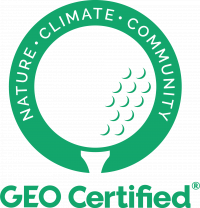On 27 September 2023, Golf de Lavaux was awarded GEO Certified® certification by the GEO Foundation, making it the 39th course in Switzerland to be so certified. This is a remarkable achievement and an important milestone for our club!
The ‘Golf Course 2030 Switzerland’ strategy stipulates that by 2027, all clubs affiliated to the Swiss Golf Federation must be GEO or ISO 14001 certified, or have enshrined their commitment to sustainable development in their articles of association.
Sustainable development is based on the three pillars of economy, ecology and society. For Swiss Golf, sustainability has become a cornerstone of golf culture and will shape the future of the sport in Switzerland. Swiss Golf aims to showcase the ecological, economic and social aspects of golf, and to raise awareness among golfers of the importance of sustainability for their favourite sport.
The Golf Environment Organization (GEO) Foundation, a non-profit organisation based in Scotland, developed and manages the OnCourse® digital tool, which is the world's leading system for measuring sustainability in golf. It is this tool, chosen by Swiss Golf for Swiss golf courses, that was used to assess sustainability at Golf de Lavaux. The assessment was carried out by an independent GEO-accredited expert, Mr Hector Forsen, on the basis of a detailed questionnaire submitted to the club in advance. Mr Forsen was also at Golf de Lavaux on 7 September to carry out an in-depth audit of the facilities and the course before finalising his report. The report is structured around three main themes: nature (biodiversity, course maintenance and pollution prevention), resources (water and energy management, use and recycling of materials), and the community (public relations, multifunctionality of golf facilities, inclusiveness and integration into the local fabric).
The report notes in its introduction that Golf de Lavaux ‘is professionally managed, continually improves sustainability, considers and protects nature in its activities, collaborates effectively with local stakeholders and authorities, and contributes to the development of golf in Switzerland.’
Golf de Lavaux's ecological balance sheet is an important part of the assessment. GEO® certification recognises all the efforts made by our club to protect the environment since it was founded. The final report notes the creation of ecological compensation areas in collaboration with the cantonal authorities, the planting of numerous trees (including high-stem fruit trees under the aegis of the Pro Specie Rara foundation), the existence of ecological zones and other refuge areas for wild fauna and flora on the course, and the installation of numerous nesting boxes for threatened species. Among other initiatives taken by the club in recent years, the report highlights the efforts made to limit the use of fertilisers, the use of plant waste in a local biogas production facility, and the installation of photovoltaic panels on the roof of the new caddy room.
GEO certification is a dynamic process and is subject to periodic review. The final report contains a number of recommendations that will help our club to further improve its sustainability record in the years to come.
The Board would like to thank our Director, Mr Alexander Brülhart, our Course Manager, Mr Richard McGlynn, and all the club's staff for their commitment and efforts in this venture.
